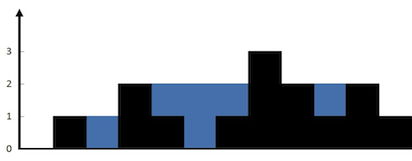给定 n 个非负整数表示每个宽度为 1 的柱子的高度图,计算按此排列的柱子,下雨之后能接多少雨水。

上面是由数组 [0,1,0,2,1,0,1,3,2,1,2,1] 表示的高度图,在这种情况下,可以接 6 个单位的雨水(蓝色部分表示雨水)。 感谢 Marcos 贡献此图。
示例:
输入: [0,1,0,2,1,0,1,3,2,1,2,1]
输出: 6
来源:力扣(LeetCode)
链接:https://leetcode-cn.com/problems/trapping-rain-water
著作权归领扣网络所有。商业转载请联系官方授权,非商业转载请注明出处。
看到这样的题目一般能快速想到的办法就是双指针了,last指针记录上一波的最高柱子,另一个从0开始递增,
在遇到height[i] >= height[last_top]的时候,将i和last之间的高度差累计
OK,可是这样会遇到个问题,在遇到最高的柱子右边的时候这规则就不适用了,是不是这样双指针就不行了呢。
nonono,换个方向想想看,把整片柱子分开两段,最高柱子的左边和最高柱子的右边,
这不就是两个双指针的思路么,最后就很容易计算最后的值了
class Solution { public: int trap(vector<int>& height) { int last_top(0); int ret(0); int top_index(0);// for (int i=0;i < height.size(); i++) { if (height[i] > height[top_index]) { top_index = i; } } //1 for (int i = 1; i <= top_index;) { if (height[i] >= height[last_top]) { for (int j = last_top+1; j < i;++j) { ret += height[last_top] - height[j]; } last_top = i; i++; } else{ i++; } } last_top = height.size() -1; for (int i = last_top - 1; i >= top_index;) { if (height[i] >= height[last_top]) { for (int j = last_top - 1; j > i; --j) { ret += height[last_top] - height[j]; } last_top = i; i--; } else { i--; } } return ret; } };
想复杂点的话,可以按照LeetCode官方解题,使用栈(好像这样比较高级,速度也比较快)
用一个栈记录在遇到 height[current] > height[st.top() 之前的所有柱子的序号
class Solution { public: int trap(vector<int>& height) { int ans = 0, current = 0; stack<int> st; while (current < height.size()) { while (!st.empty() && height[current] > height[st.top()]) { int top = st.top(); st.pop(); if (st.empty()) break; int distance = current - st.top() - 1; int bounded_height = min(height[current], height[st.top()]) - height[top]; ans += distance * bounded_height; } st.push(current++); } return ans; } };